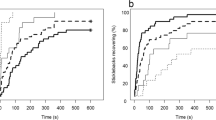Abstract
The immature stages of some parasites live in prey animals (intermediate hosts) and only reach reproductive maturity when they are eaten by final host predators. Some of these parasites alter intermediate host behavior in ways that increase the likelihood of predation (parasite transmission). Using the acanthocephalan (Moniliformis moniliformis) in the cockroach (Periplaneta americana), we show that infected cockroaches experienced a decrease in wind-evoked escape responses, a predator avoidance behavior, that consisted of fewer escape responses, longer latency and higher threshold for escape behavior. We found no correlates of the impairment of the escape behavior in the abdominal portion of the escape neuronal circuitry. This study demonstrates a parasite-induced alteration of a behavior dedicated to predator avoidance.
Similar content being viewed by others
REFERENCES
Beckage, N. E. (1985). Endocrine interactions between endoparasitic insects and their hosts. Ann. Rev. Entomol 30: 371-413.
Beckage, N. E. (1991). Host-parasite hormonal relationships: a common theme? Exp. Parasitol. 72: 332-338.
Camhi, J. M. (1984). A case study: The escape system of the cockroach. In Neuroethology: Nerve Cells and Natural Behavior of Animals. Sinauer, Sunderland, Mass, pp. 79-105.
Camhi, J. M., and Nolen, T. G. (1981). Properties of the escape system of cockroaches during walking. J. Comp Physiol A 142: 339-346.
Carmichael, L. M., Moore, J., and Bjostad, L. B. (1993). Parasitism and decreased response to sex pheromones in male Periplaneta americana (Dictyoptera: Blattidae). J. Insect Behav. 6: 25-32.
Casagrand, J. L., and Ritzmann, R. E. (199b). Biogenic amines modulate synaptic transmission between identified giant interneurons and thoracic interneurons in the escape system of the cockroach. J. Neurobiol. 23: 644-655.
De Jong-Brink, M. (1995). How schistosomes profit from the stress responses they elicit in their hosts. Advan. Parasitol. 35: 178-256.
Gotelli, N. J., and Moore, J. (1992). Altered host behaviour in a cockroach-acanthocephalan association. Animal Behav. 43: 949-959.
Helluy, S., and Holmes, J. C. (1990). Serotonin, octopamine, and the clinging behavior induced by the parasite Polymorphus paradoxus (Acanthocephala) in Gammarus lacustris (Crustacea). Canad. J. Zool. 68: 1214-1220.
Hurd, H. (1990). Physiological and behavioural interactions between parasites and invertebrate hosts. Advan. Parasitol. 29: 271-318.
Kavaliers, M., and Colwell, D. D. (1992). Parasitism, opioid systems and host behaviour. Advan. Neuroimmunol. 2: 287-295.
Kavaliers, M., and Colwell, D. D. (1994). Parasite infection attenuates nonopioid mediated predator-induced analgesia in mice. Physiol. Behav. 55: 505-510.
Libersat, F. (1992). Modulation of flight by the giant interneurons in the cockroach: Periplaneta americana. J. Comp. Physiol. A 170: 379-392.
Molyneux, D. H., and Jefferies, D. (1986). Feeding behaviour of pathogen-infected vectors. Parasitology. 92: 721-736.
Moore, J. (1984). Altered behavior in intermediate hosts-An acanthocephalan parasite strategy. Am. Naturalist 123: 572-577.
Moore, J. (1993). Parasites and the behavior of biting flies. J. Parasitol. 79: 1-16.
Moore, J., and Gotelli, N. J. (1990). Phylogenetic perspective on the evolution of altered host behaviours: a critical look at the manipulation hypothesis. In Barnard, C. J., and Behnke, J. M. (eds.), Parasitism and Host Behaviour, Taylor and Francis, London, pp. 193-233.
Ritzmann, R. E. (1993). The neural organization of cockroach escape and its role in context dependent orientation. In Beer, R. D., Ritzmann, R. E., and McKenna, T. (eds.), Biological Neural Networks in Invertebrate Neuroethology and Robotics, Academic Press, pp. 113-137.
Thompson, S. N. (1990). Physiological alterations during parasitism and their effects on host behaviour. In Barnard, C. J., and Behnke, J. M. (eds.), Parasitism and Host Behaviour, Taylor and Francis, London. pp. 64-94.
Thompson, S. N., and Kavaliers, M. (1994). Physiological bases of parasite-induced alterations of host behaviour. Parasitology 109: S119-S138.
Watson, J. T., and Ritzmann, R. E. (1994). The escape response versus the quiescent response of the American cockroach: Behavioural choice mediated by physiological state. Animal Behav. 48: 76-478.
Author information
Authors and Affiliations
Rights and permissions
About this article
Cite this article
Libersat, F., Moore, J. The Parasite Moniliformis moniliformis Alters the Escape Response of its Cockroach Host Periplaneta americana. Journal of Insect Behavior 13, 103–110 (2000). https://doi.org/10.1023/A:1007719710664
Issue Date:
DOI: https://doi.org/10.1023/A:1007719710664




